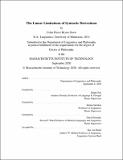| dc.contributor.advisor | Danny Fox, Sabine Iatridou, and David Pesetsky. | en_US |
| dc.contributor.author | Davis, Colin Pierce Bryon. | en_US |
| dc.contributor.other | Massachusetts Institute of Technology. Department of Linguistics and Philosophy. | en_US |
| dc.date.accessioned | 2021-01-06T17:41:19Z | |
| dc.date.available | 2021-01-06T17:41:19Z | |
| dc.date.copyright | 2020 | en_US |
| dc.date.issued | 2020 | en_US |
| dc.identifier.uri | https://hdl.handle.net/1721.1/129122 | |
| dc.description | Thesis: Ph. D. in Linguistics, Massachusetts Institute of Technology, Department of Linguistics and Philosophy, September, 2020 | en_US |
| dc.description | Cataloged from student-submitted PDF version of thesis. | en_US |
| dc.description | Includes bibliographical references (pages 349-370). | en_US |
| dc.description.abstract | In this dissertation, I identify and analyze several new generalizations about how phrasal displacement and discontinuity are constrained in natural language. These patterns reveal, I argue, that many limitations of syntactic derivations are attributable to the way in which syntactic operations are cyclically interleaved with the component of the grammar that establishes word order. This finding has consequences for many phenomena, and for the architecture of grammar in general. Chapter 1 introduces the theory of cyclic linearization that serves as the foundation for this work, and several principles about the locality of movement that importantly interact with it. Chapter 2 shows that these concepts predict the crosslinguistic distribution of stranding in intermediate positions. Chapter 3 extends these considerations to an analysis of possessor extraction in colloquial English, a phenomenon subject to numerous intricate but systematic limitations. Chapter 4 provides further evidence for the theory advanced here from constraints on subextraction in Russian. Chapter 5 argues that certain facts about parasitic gaps in sentences with overlapping moved phrases reveal further evidence that linearization constrains syntactic derivations, with consequences for the nature of movement more generally. Chapter 6 argues that linear order constrains extraposition, and proposes an account of this phenomenon that addresses a number of puzzles about its distribution. Chapter 7 diverges from the theme of linearization to explore parasitic gaps in relative clauses, which connect to several results from chapter 5. Chapter 8 summarizes the findings of this dissertation, and discusses several more general implications of the framework advanced here. | en_US |
| dc.description.statementofresponsibility | by Colin Pierce Bryon Davis. | en_US |
| dc.format.extent | 370 pages | en_US |
| dc.language.iso | eng | en_US |
| dc.publisher | Massachusetts Institute of Technology | en_US |
| dc.rights | MIT theses may be protected by copyright. Please reuse MIT thesis content according to the MIT Libraries Permissions Policy, which is available through the URL provided. | en_US |
| dc.rights.uri | http://dspace.mit.edu/handle/1721.1/7582 | en_US |
| dc.subject | Linguistics and Philosophy. | en_US |
| dc.title | The linear limitations of syntactic derivations | en_US |
| dc.type | Thesis | en_US |
| dc.description.degree | Ph. D. in Linguistics | en_US |
| dc.contributor.department | Massachusetts Institute of Technology. Department of Linguistics and Philosophy | en_US |
| dc.identifier.oclc | 1227162170 | en_US |
| dc.description.collection | Ph.D.inLinguistics Massachusetts Institute of Technology, Department of Linguistics and Philosophy | en_US |
| dspace.imported | 2021-01-06T17:41:18Z | en_US |
| mit.thesis.degree | Doctoral | en_US |
| mit.thesis.department | Ling | en_US |
